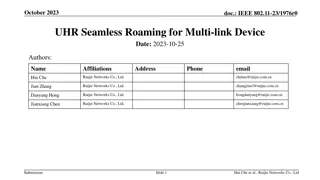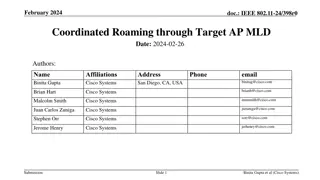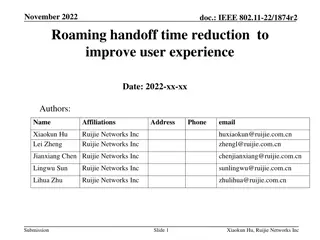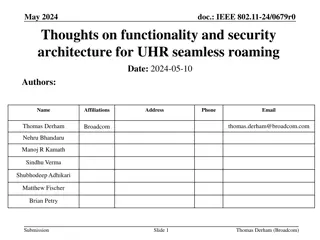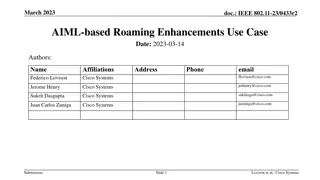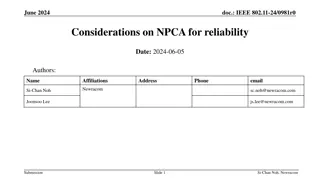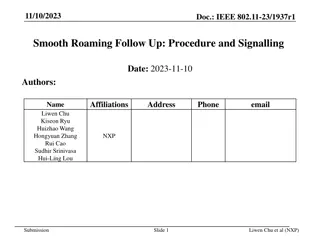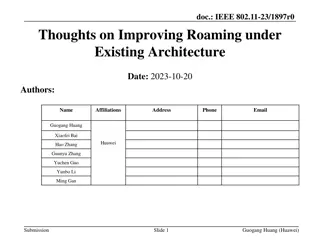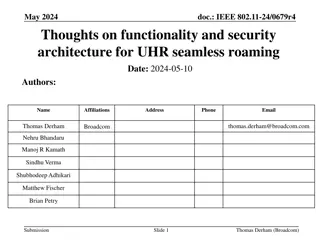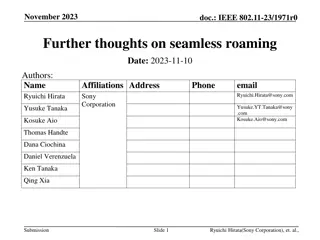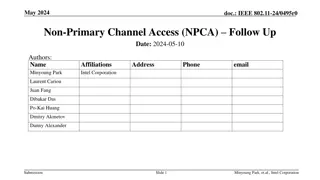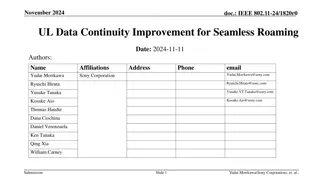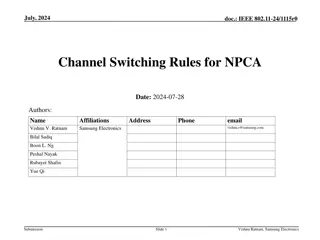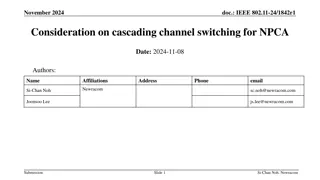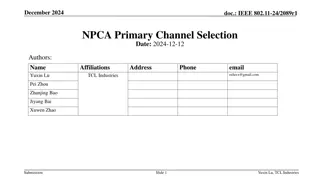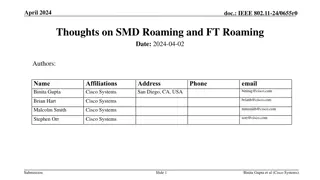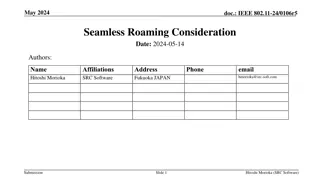
Enhancing Seamless Roaming with NCPA for Improved Performance
Explore the challenges in seamless roaming scenarios with NCPA integration, proposing a solution where the target AP MLD communicates NCPA status to the non-AP MLD via the current AP MLD. This innovative approach aims to optimize the seamless roaming process by addressing channel view discrepancies, enhancing monitoring capabilities, and timely transmission of Roaming Request frames for efficient performance.
Download Presentation

Please find below an Image/Link to download the presentation.
The content on the website is provided AS IS for your information and personal use only. It may not be sold, licensed, or shared on other websites without obtaining consent from the author. If you encounter any issues during the download, it is possible that the publisher has removed the file from their server.
You are allowed to download the files provided on this website for personal or commercial use, subject to the condition that they are used lawfully. All files are the property of their respective owners.
The content on the website is provided AS IS for your information and personal use only. It may not be sold, licensed, or shared on other websites without obtaining consent from the author.
E N D
Presentation Transcript
January 2025 doc.: IEEE 802.11-1591r4 Thoughts on Seamless Roaming and NPCA Date: 2025-01-6 Authors: Name Affiliation Address Phone Email Ning Gao gaoning1@oppo.com Chaoming Luo Liuming Lu OPPO Liangxiao Xin Dong Wei Yapu li Submission Slide 1 Ning Gao (OPPO)
January 2025 doc.: IEEE 802.11-1591r4 Introduction Seamless Roaming enables context transfer and/or data transfer between current AP MLD and target AP MLD so as to make the roaming procedure faster. NPCA enables a STA to access the NPCA primary channel while the BSS primary channel is known to be busy due to OBSS traffic or other conditions. In this contribution, we would like to discuss a different view of channel problem when take the seamless roaming and NPCA into consideration at the same time. Submission Slide 2 Ning Gao (OPPO)
January 2025 doc.: IEEE 802.11-1591r4 Scenario and Problem Assume an NPCA-enabled seamless roaming scenario, after the roaming preparation phase, the non-AP MLD will monitor the RSSI with the target AP MLD. [1, 2] the non-AP MLD will send a Roaming Request frame to the target AP MLD when appropriate. [1, 2] Since roaming usually occurs at the edge of a BSS, the non-AP MLD and the target AP MLD may suffer a more severe different view of channel problem, the non-AP MLD is on BSS P-CH while the target AP MLD is on NPCA P-CH. the non-AP MLD is on NPCA P-CH while the target AP MLD is on BSS P-CH. As a result, the non-AP MLD may miss some opportunities to monitor the RSSI with the target AP MLD. the non-AP MLD may not be able to send the Roaming Request frame to the target AP MLD in time. Finally, a delayed Roaming Request frame will reduce the seamless roaming performance. Current AP MLD Target AP MLD DS NPCA P-CH Different View of Channel BSS P-CH Seamless Roaming Non-AP MLD Submission Slide 3 Ning Gao (OPPO)
January 2025 doc.: IEEE 802.11-1591r4 Proposed Solution Proposed: Target AP MLD informs non-AP MLD of its NPCA Status and Expiration Time information through the current AP MLD The NPCA Status may include BSS/NPCA P-CH, Dwell Time, and Max BW. The Expiration Time may be a TSF timestamp. If the received Expiration Time has not expired, the non-AP MLD may switch to the NPCA P- CH if the target AP MLD is still on it. Then, monitor the RSSI and/or send a Roaming Request frame to the target AP MLD if needed. This approach can make the NPCA-enabled seamless roaming procedure more effective. Current AP MLD Target AP MLD DS NPCA Status & Expiration Time NPCA P-CH Same View of Channel NPCA P-CH Seamless Roaming Non-AP MLD Submission Slide 4 Ning Gao (OPPO)
January 2025 doc.: IEEE 802.11-1591r4 Summary A different view of channel problem is discussed in an NPCA-enabled seamless roaming scenario. Since roaming usually occurs at the edge of a BSS, the non-AP MLD and the target AP MLD may suffer a more severe different view of channel problem. Due to this problem, the non-AP MLD may miss some opportunities to monitor the RSSI with the target AP MLD and may be unable to send the Roaming Request frame to the target AP MLD in time. To solve this problem, a solution that transmits the NPCA status of the target AP MLD and the expiration time to the non-AP MLD through the current AP MLD is proposed. This approach can make the NPCA-enabled seamless roaming procedure more effective. Further discussion on this problem may be needed. Submission Slide 5 Ning Gao (OPPO)
January 2025 doc.: IEEE 802.11-1591r4 Reference [1] 11-24-0349-03-00bn-enhanced-fast-bss-transition, Guogang Huang [2] 11-24-1812-00-00bn-seamless-roaming-through-a-target-ap-follow-up, Binita Gupta Submission Slide 6 Ning Gao (OPPO)
January 2025 doc.: IEEE 802.11-1591r4 SP 1 Do you agree that the different view of channel problem (shown in slide 3) should be considered when NPCA is enabled in seamless roaming procedure? Yes/No/Abstain Submission Slide 7 Ning Gao (OPPO)

